Convergence Case Basics
Cases are the basic unit of data entry in a Convergence Database. All notes, events, documents, or invoices in the system are attached to a case. Each case has a client and a list of contacts or parties to the case. Contact records may refer to case related organizations and contacts such as Employers, Lawyers, Doctors, Training Programs, etc. The types of contacts that can be added to a case are set by the Convergence admin user.
The word 'Case' may be replaced by a different word in your Covergence setup. The admin user may rename them to fit your business model, such as calling cases Accounts, Customers, or Dossiers. Likewise, the client for each case may be named something different, such as Claimant, Plaintiff, Defendant, Patient, etc. For purposes of this manual, the words Case and Client will be used to refer to these data records.
Entering new cases

To start a new case, click 'New Case' in the popup menu or the navigation page. This will bring you to a form to fill out case and client data. The text fields to fill in may look different from what is shown below, depending on your database setup.
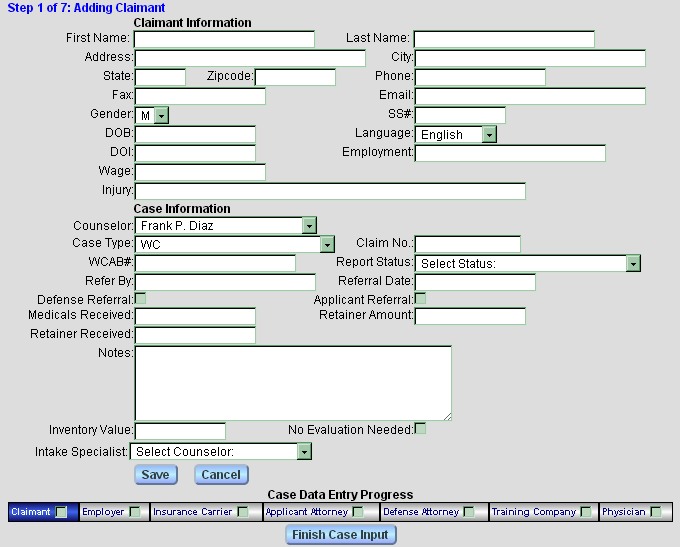
Fill in your case data in the blanks provided, and click the button 'Save' to move on to the next step of case entry. A progress bar below indicates how much of the case and case contact data you have entered so far. Clicking the button 'Finish Case Input' will save the case as is without moving on to the next step. You can always revisit a case to add, delete, or modify its contact info. The button 'Cancel' will submit the form without saving your data. In general, a 'Cancel' button in Convergence is the way to leave a form without saving. Convergence will also not save empty forms or unnamed cases.
The elements that make up the case progress bar, and the order they appear in can be modfied by the admin user. The progress bar sections of the case can be contacts, parties, or records that are part of the case, as set up by admin. The progress bar you see may be different from the one in the picture above.
Case List
To view a list of all the cases you are allowed to see, just click 'Case List' in the top bar. This list has many useful features to examine case data, or upload files to a case. This same type of list will also appear when you search for cases, listing the cases that match your search.
Each case in the list has a set of links to the right for quick access to case notes, invoicing, listing forms and documents, or closing cases if you have the privilege to do so.

This list may be sorted by any datafield value by using the 'Sort Cases By:' menu at the top of the list.
To view additional information about each case, click the '+' button to the right of the listing, and extra information will appear as shown below. (Admin only: This extra case information section is a template that the admin user can change to use your choice of data fields and layout. See Template Management.)

To close the extra case info, just click the '-' button that is now to the right of the listing.
Case lists contain a handy popout section for managing, uploading, and generating files from a case right in the list screen. If a case contains documents in its directory, a filled file icon will show up next to the '+' button, and if no files are in that case's directory, an empty file icon will show up in that spot. Click on the file icon to expand the case list, or to hide it if it is already showing. The case file list shows all uploaded files, letters, reports, etc. for your case. Subfolders may be created, and files can be dragged by their icons into folders. Clicking on a file name will take you to that file or document. If it is an uploaded file, it will send it to you, and if it is a generated document, you will see a screen to print or edit the document from. See File Management for more details about case file directories and folders.
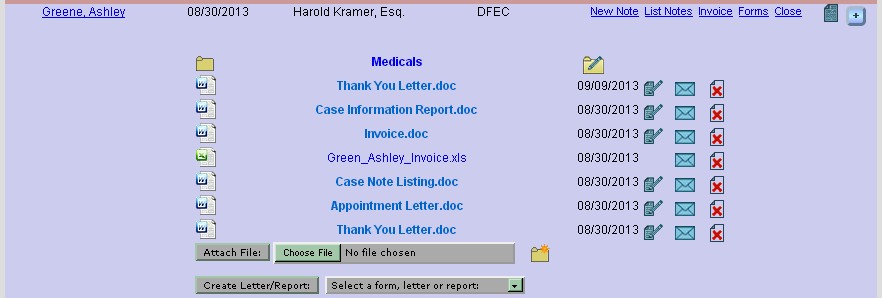
To open a folder, just click on the folder and view the files within.

To create a new folder, click on the little sparkle folder icon, and you will be prompted for the name of your new folder. Folders may be dragged inside of other folders. The edit folder icon to the right of the folder name allows you to rename the folder.
To upload a file to the case, click 'Choose File' in the upload control at the bottom of the list, navigate to a file in your hard drive you want to upload, and click the 'Attach File:' button. To generate a new letter or report for the case, choose a template from the menu marked 'Choose a form, letter, or report:' and click the button 'Create Letter/Report'. Uploaded files and new template documents will show up immediately in the file directory once they are in the system. There may be a delay with uploading larger files.
Closed Cases
When cases are closed, they no longer appear in regular case lists and searches. To view your closed cases, click 'Closed Cases' in the popup menu, and a list of closed cases will appear. These cases may be reopened from this list if needed.

Closed cases can also be found using case searches, if the search checkbox 'Include Closed Cases' is checked.
Editing Cases
Clicking on the name of a case in a case list will take you to a case editing page, where case data may be revised or added to as needed, if you have the privilege to modify the case. Your changes will be automatically saved unless you use your browser's back button to back out.
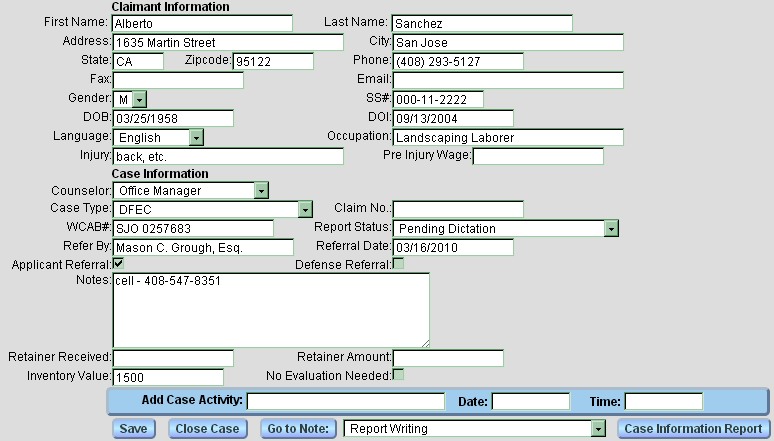
At the bottom of the editing area is an optional Case Activity form for marking dates and events related to the case. The Case Activity field is an autocomplete that will popup exisitng activity names as you type. The date and time fields have calendar and time picker popups to make it easier to enter a date and time. Case Activities will also show up in the case schedule. This feature may be turned off by admin, so that activities or events are entered only with the event popup.
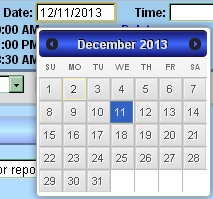
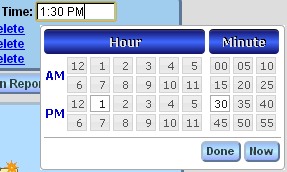
Below the case editing form is an expanded version of the case directory, with all the same features as the popout directory that appears in case lists. See File Management for more details.
Searching for cases
The quickest way to find cases is to use the Find Cases button and field in the Convergence top bar. This will match any substring of the case name for your results.
Sometimes, a more detailed set of search criteria are needed to find which case or cases you are looking for. The menu time 'Find Cases' takes you to a page where you may choose any data field as a search criterion. There are options to search for cases of a particular user, to include closed or deleted cases, and to choose exact or substring matches in your data fields. For date fields, a date may be typed in, or a range of dates like "07/14/15 to 09/15/15".
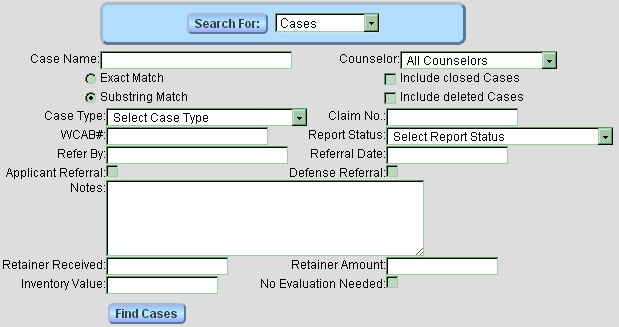
When you click the 'Find Cases' button, you get a listing of cases that match your search. This has all the same features as the master case list, and a label indicating which kind of search produced this list. See Case List for more details about case lists.

When a case search includes closed cases, and a miz of open and closed cases is found, the closed cases are in a separate popout list below the open case results, and color coded differently than open cases.

Click on 'Show Closed Cases' to expand the list of closed cases that match your search.

Clicking on 'Hide Closed Cases' will collapse the list back to the 'Show Closed Cases' link.
This manual is published by Convergence Case Management Data Retrieval Software, LLC, whose software products are provided for use by parties who have paid for and have a current license to operate the software described herein.
Information in this manual is subject to change without notice, and does not represent any commitment on the part of Convergence Case Management Data Retrieval Software, LLC. The software described in this manual is furnished under a license agreement and may be used only in accordance with its terms and conditions.
© Copyright 2026 Convergence Case Management Data Retrieval Software, LLC
This manual contains propietary information which is protected by Copyright. No part of this document may be reproduced, translated into any language or computer language, or transmitted in any form whatsoever without the prior written consent of Convergence Case Management Data Retrieval Software, LLC.
